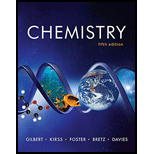
Concept explainers
(a)
Interpretation: The given statements are to be authenticated.
Concept introduction: The liquid whose particles are present above the solution is known as the volatile liquid.
To determine: The authenticity of the given statement, “X is the solvent in the given solution”.
(a)
Answer to Problem 11.1VP
Solution
The given statement is correct.
Explanation of Solution
Explanation
Given
The blue balls in the given figure are present in large number and denote the particles of component X.
The red balls in the given figure are present in small quantity and denote the particles of component Y.
The solution is the term refers to the mixture of solute and solvent. The solute is the component of the solution which is present in less quantity in the solution. The small quantity of solution is dissolved in the solvent, which is present in the large quantity in the solution. This solute and solvent combine together and form a mixture called solution.
Since, the particles of component X are present in large quantity in the given solution. Therefore, X is the solvent in the given system.
(b)
To determine: The authenticity of the given statement, “Pure Y is a volatile liquid”.
(b)
Answer to Problem 11.1VP
Solution
The given statement is incorrect.
Explanation of Solution
Explanation
Given
The particles of component X exists above the solution.
The particles of component Y exists in the solution.
The volatile liquid is the liquid whose particles exist above the solution. Since, the particles of component Y do not exist above the solution. Therefore, component Y is the non-volatile liquid.
(c)
To determine: The authenticity of the given statement, “If Y were not present, there would be fewer X particles in the gas above the liquid solution”.
(c)
Answer to Problem 11.1VP
Solution
The given statement is incorrect.
Explanation of Solution
Explanation
Given
The liquid Y is the non volatile solute.
The liquid X is the volatile solvent.
The addition of non volatile solute to the volatile solvent results in the elevation in the boiling point. Due to the increase in the boiling point the number of particles of solvent above the solution decreases. Therefore, the presence of solvent Y results in the lesser particles of X above the solution.
(d)
To determine: The authenticity of the given statement, “The presence of Y increases the vapor pressure of X”.
(d)
Answer to Problem 11.1VP
Solution
The given statement is incorrect.
Explanation of Solution
Explanation
The vapor pressure of solvent is the colligative property. It depends upon the mole fraction and the vapor pressure of pure solvent. The vapor pressure of the solvent is independent of the pressure of solute particles. Therefore, the given statement is incorrect.
Conclusion
- a. The given statement is appropriate.
- b. The given statement is inappropriate.
- c. The given statement is inappropriate.
- d. The given statement is inappropriate.
Want to see more full solutions like this?
Chapter 11 Solutions
Chemistry: The Science in Context (Fifth Edition)
- What is the final product when hexanedioic acid reacts with 1º PCl5 and 2º NH3.arrow_forwardWhat is the final product when D-galactose reacts with hydroxylamine?arrow_forwardIndicate the formula of the product obtained by reacting methyl 5-chloro-5-oxopentanoate with 1 mole of 4-penten-1-ylmagnesium bromide.arrow_forward
- The temperature on a sample of pure X held at 1.25 atm and -54. °C is increased until the sample boils. The temperature is then held constant and the pressure is decreased by 0.42 atm. On the phase diagram below draw a path that shows this set of changes. pressure (atm) 2 0 0 200 400 temperature (K) Xarrow_forwardQUESTION: Answer Question 5: 'Calculating standard error of regression' STEP 1 by filling in all the empty green boxes *The values are all provided in the photo attached*arrow_forwardpressure (atm) 3 The pressure on a sample of pure X held at 47. °C and 0.88 atm is increased until the sample condenses. The pressure is then held constant and the temperature is decreased by 82. °C. On the phase diagram below draw a path that shows this set of changes. 0 0 200 temperature (K) 400 аarrow_forward
 ChemistryChemistryISBN:9781305957404Author:Steven S. Zumdahl, Susan A. Zumdahl, Donald J. DeCostePublisher:Cengage Learning
ChemistryChemistryISBN:9781305957404Author:Steven S. Zumdahl, Susan A. Zumdahl, Donald J. DeCostePublisher:Cengage Learning ChemistryChemistryISBN:9781259911156Author:Raymond Chang Dr., Jason Overby ProfessorPublisher:McGraw-Hill Education
ChemistryChemistryISBN:9781259911156Author:Raymond Chang Dr., Jason Overby ProfessorPublisher:McGraw-Hill Education Principles of Instrumental AnalysisChemistryISBN:9781305577213Author:Douglas A. Skoog, F. James Holler, Stanley R. CrouchPublisher:Cengage Learning
Principles of Instrumental AnalysisChemistryISBN:9781305577213Author:Douglas A. Skoog, F. James Holler, Stanley R. CrouchPublisher:Cengage Learning Organic ChemistryChemistryISBN:9780078021558Author:Janice Gorzynski Smith Dr.Publisher:McGraw-Hill Education
Organic ChemistryChemistryISBN:9780078021558Author:Janice Gorzynski Smith Dr.Publisher:McGraw-Hill Education Chemistry: Principles and ReactionsChemistryISBN:9781305079373Author:William L. Masterton, Cecile N. HurleyPublisher:Cengage Learning
Chemistry: Principles and ReactionsChemistryISBN:9781305079373Author:William L. Masterton, Cecile N. HurleyPublisher:Cengage Learning Elementary Principles of Chemical Processes, Bind...ChemistryISBN:9781118431221Author:Richard M. Felder, Ronald W. Rousseau, Lisa G. BullardPublisher:WILEY
Elementary Principles of Chemical Processes, Bind...ChemistryISBN:9781118431221Author:Richard M. Felder, Ronald W. Rousseau, Lisa G. BullardPublisher:WILEY





